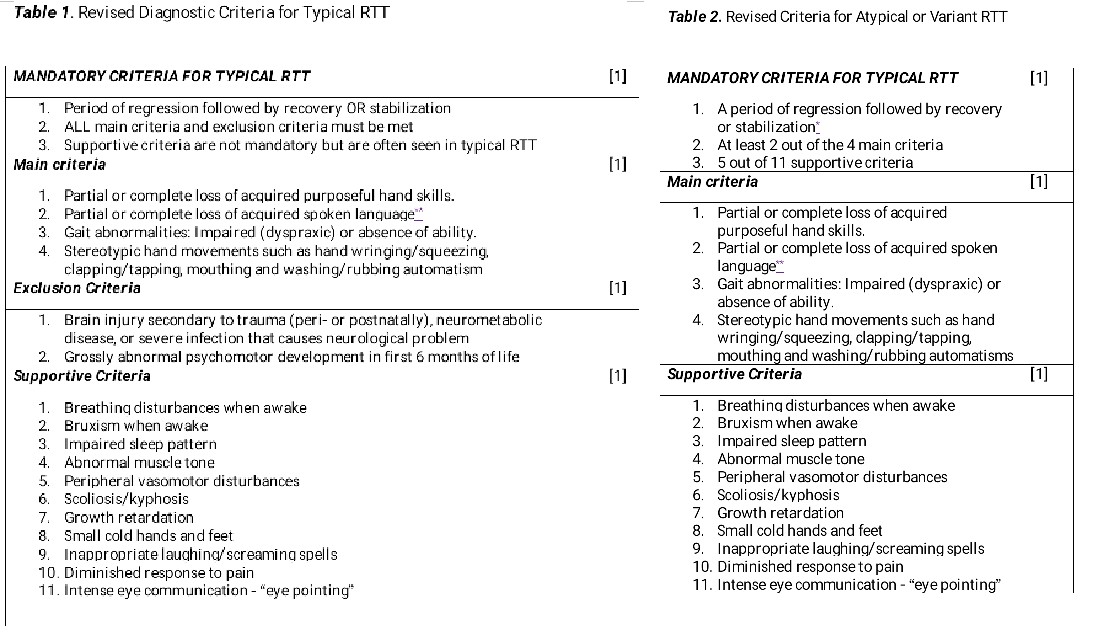[1]
Operto FF, Mazza R, Pastorino GMG, Verrotti A, Coppola G. Epilepsy and genetic in Rett syndrome: A review. Brain and behavior. 2019 May:9(5):e01250. doi: 10.1002/brb3.1250. Epub 2019 Mar 30
[PubMed PMID: 30929312]
[2]
Martínez-Rodríguez E, Martín-Sánchez A, Coviello S, Foiani C, Kul E, Stork O, Martínez-García F, Nacher J, Lanuza E, Santos M, Agustín-Pavón C. Lack of MeCP2 leads to region-specific increase of doublecortin in the olfactory system. Brain structure & function. 2019 May:224(4):1647-1658. doi: 10.1007/s00429-019-01860-6. Epub 2019 Mar 28
[PubMed PMID: 30923887]
[3]
Ehrhart F, Coort SL, Eijssen L, Cirillo E, Smeets EE, Bahram Sangani N, Evelo CT, Curfs LMG. Integrated analysis of human transcriptome data for Rett syndrome finds a network of involved genes. The world journal of biological psychiatry : the official journal of the World Federation of Societies of Biological Psychiatry. 2020 Dec:21(10):712-725. doi: 10.1080/15622975.2019.1593501. Epub 2019 Apr 29
[PubMed PMID: 30907210]
[4]
Einspieler C, Marschik PB. Regression in Rett syndrome: Developmental pathways to its onset. Neuroscience and biobehavioral reviews. 2019 Mar:98():320-332. doi: 10.1016/j.neubiorev.2019.01.028. Epub
[PubMed PMID: 30832924]
[5]
Banerjee A, Miller MT, Li K, Sur M, Kaufmann WE. Towards a better diagnosis and treatment of Rett syndrome: a model synaptic disorder. Brain : a journal of neurology. 2019 Feb 1:142(2):239-248. doi: 10.1093/brain/awy323. Epub
[PubMed PMID: 30649225]
[6]
Vashi N, Justice MJ. Treating Rett syndrome: from mouse models to human therapies. Mammalian genome : official journal of the International Mammalian Genome Society. 2019 Jun:30(5-6):90-110. doi: 10.1007/s00335-019-09793-5. Epub 2019 Feb 28
[PubMed PMID: 30820643]
[7]
Gold WA, Krishnarajy R, Ellaway C, Christodoulou J. Rett Syndrome: A Genetic Update and Clinical Review Focusing on Comorbidities. ACS chemical neuroscience. 2018 Feb 21:9(2):167-176. doi: 10.1021/acschemneuro.7b00346. Epub 2017 Dec 15
[PubMed PMID: 29185709]
[8]
Neul JL, Benke TA, Marsh ED, Skinner SA, Merritt J, Lieberman DN, Standridge S, Feyma T, Heydemann P, Peters S, Ryther R, Jones M, Suter B, Kaufmann WE, Glaze DG, Percy AK. The array of clinical phenotypes of males with mutations in Methyl-CpG binding protein 2. American journal of medical genetics. Part B, Neuropsychiatric genetics : the official publication of the International Society of Psychiatric Genetics. 2019 Jan:180(1):55-67. doi: 10.1002/ajmg.b.32707. Epub 2018 Dec 7
[PubMed PMID: 30536762]
[9]
Zengin-Akkuş P, Taşkıran EZ, Kabaçam S, Şimşek-Kiper PÖ, Haliloğlu G, Boduroğlu K, Utine GE. Clinical and molecular evaluation of 16 patients with Rett syndrome. The Turkish journal of pediatrics. 2018:60(1):1-9. doi: 10.24953/turkjped.2018.01.001. Epub
[PubMed PMID: 30102473]
[10]
Schönewolf-Greulich B, Bisgaard AM, Møller RS, Dunø M, Brøndum-Nielsen K, Kaur S, Van Bergen NJ, Lunke S, Eggers S, Jespersgaard C, Christodoulou J, Tümer Z. Clinician's guide to genes associated with Rett-like phenotypes-Investigation of a Danish cohort and review of the literature. Clinical genetics. 2019 Feb:95(2):221-230. doi: 10.1111/cge.13153. Epub 2018 Jan 25
[PubMed PMID: 29023665]
[11]
Sadeghi S, Shevell M. Consideration of Genetic Diagnoses of Developmental Delay in Children of Consanguineous Families. Seminars in pediatric neurology. 2018 Jul:26():60-62. doi: 10.1016/j.spen.2017.03.007. Epub 2017 Apr 1
[PubMed PMID: 29961522]
[12]
Jefferson A, Leonard H, Siafarikas A, Woodhead H, Fyfe S, Ward LM, Munns C, Motil K, Tarquinio D, Shapiro JR, Brismar T, Ben-Zeev B, Bisgaard AM, Coppola G, Ellaway C, Freilinger M, Geerts S, Humphreys P, Jones M, Lane J, Larsson G, Lotan M, Percy A, Pineda M, Skinner S, Syhler B, Thompson S, Weiss B, Witt Engerström I, Downs J. Clinical Guidelines for Management of Bone Health in Rett Syndrome Based on Expert Consensus and Available Evidence. PloS one. 2016:11(2):e0146824. doi: 10.1371/journal.pone.0146824. Epub 2016 Feb 5
[PubMed PMID: 26849438]
Level 3 (low-level) evidence
[13]
Leonard H, Ravikumara M, Baikie G, Naseem N, Ellaway C, Percy A, Abraham S, Geerts S, Lane J, Jones M, Bathgate K, Downs J, Telethon Institute for Child Health Research. Assessment and management of nutrition and growth in Rett syndrome. Journal of pediatric gastroenterology and nutrition. 2013 Oct:57(4):451-60. doi: 10.1097/MPG.0b013e31829e0b65. Epub
[PubMed PMID: 24084372]
[14]
Vignoli A, La Briola F, Peron A, Turner K, Savini M, Cogliati F, Russo S, Canevini MP. Medical care of adolescents and women with Rett syndrome: an Italian study. American journal of medical genetics. Part A. 2012 Jan:158A(1):13-8. doi: 10.1002/ajmg.a.34367. Epub 2011 Dec 2
[PubMed PMID: 22139899]
[15]
Palacios-Ceña D, Famoso-Pérez P, Salom-Moreno J, Carrasco-Garrido P, Pérez-Corrales J, Paras-Bravo P, Güeita-Rodriguez J. "Living an Obstacle Course": A Qualitative Study Examining the Experiences of Caregivers of Children with Rett Syndrome. International journal of environmental research and public health. 2018 Dec 25:16(1):. doi: 10.3390/ijerph16010041. Epub 2018 Dec 25
[PubMed PMID: 30585176]
Level 2 (mid-level) evidence

